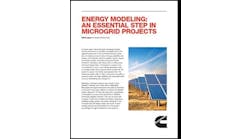Eight months on from the devastation of Hurricane Maria, the 3,160 inhabitants of Puerto Rico’s mountainous Mariana remain without grid power. Tired of waiting, community members recently took matters into their own hands with the help of a modular microgrid.
Following major damage, experts believe that 90 percent of the grid can be restored within one year, but a large financial and time investment is required to run lines to the most remote and rural areas to restore the remaining 10 percent.
“A lot of the community doesn’t expect the grid back in the way traditional grids exist. They’re looking at solar storage systems,” explains Will Heegaard, CEO of Footprint, an organization with a mission to implement sustainability practices in humanitarian response.
Some individuals have installed solar storage systems for their homes, while others rely on diesel generators.
The community led re-building effort, Proyecto de Apoyo Mutuo (Mutual Aid Project), initially started as a peer-to-peer recovery and relief service. This included going house-to-house, checking that vulnerable and elderly people had food, water, and shelter. The project is now transitioning into building long-term resilience, essential for the hurricane season.
Microgrid powered community center and laundromat
An abandoned school, turned into a community center by the Proyecto de Apoyo Mutuo team, will be powered by a recently installed BoxPower modular microgrid system. This is a place for children to study and people to work on entrepreneurial projects.
Lack of power has forced the community to hand wash their clothes, or drive to the nearest town to use the laundromat. A donation of eight washing machines to the community center and BoxPower’s system gives residents a place to do their laundry, slowly returning to some level of normality.
Relying on one source of power, like a diesel generator, can cost lives. In the first three months after the storm, diesel became difficult to source. Doctors in hospitals were performing surgeries by headlight and medications could not be refrigerated.
Doctors in hospitals were performing surgeries by headlight
The resulting deaths were not recorded as being due to the loss of power, but this was the indirect consequence. The official death toll stands at 64; but a recent Harvard University study found the toll to be over 4,600 due to power cuts and broken road links.
IKEA-like modular microgrid
BoxPower’s modular microgrid is a hybrid system with solar power, battery storage, and backup diesel generation to increase resilience and provide critical load at the very least. The system arrives fully packaged in a shipping container.
“Our system is standardized, all the electrical work is done, there’s no need for an electrician. It’s sort of like an IKEA set,” Angelo Campus, CEO of BoxPower, told Microgrid Knowledge.
A microgrid like an IKEA set…
Multiple containerized systems can be linked together to meet a load of any size, connected to the main grid, or working independently in island mode.
The BoxPower system’s solar panels can be removed and stored inside the container to prevent damage during extreme weather conditions. Members of the community, who were involved in the installation of the system, are fully trained on how to dismantle it if needed.
In this scenario, the energy management system would turn on the diesel generator, also housed inside the shipping container, to provide the center’s critical load.
The system is not without its challenges; weighing a hefty 18,000 pounds makes it difficult to transport to remote locations. After being let down by the port-to-door logistics partner, BoxPower’s system was maneuvered into its final location by a local fire fighting team and other professionals from the community.
Financing hurdles
For Heegaard, the biggest barrier for deploying modular microgrids during humanitarian response is the cost. Most non-profit response organizations budget $10,000 to $20,000 for a diesel generator system and $1,000 to $2,000 per month for diesel supply. A modular microgrid requires an upfront cost of $80,000 to $120,000.
Setting up lease-to-own agreements, which allow organizations to pay the same as the amount budgeted for diesel, is one way to combat the large upfront investment.
Convincing governments, the World Bank, or the likes of the Gates Foundation to back up these loans could promote the deployment of modular, renewable energy microgrids.
A sense of dread in Puerto Rico
As the hurricane season begins again, a sense of fear and dread fills the Mariana community, but alongside it is a strong desire to be prepared.
The Proyecto de Apoyo Mutuo volunteers are running training sessions, developing emergency response plans, and mapping the community to identify vulnerable individuals.
The belief that the government is not going to provide sufficient emergency response services to this community has led to a sense of responsibility and the determination to be self-reliant.
Learning from the islands
With little hope that the main grid will be reconnected to Mariana, Heegaard believes that their electricity future will not be a centralized grid.
“If the community is to survive the next storm, the only way this will happen is through resilient, distributed renewable generation plus storage system,” he said. “This will be the future of all of our grids. Islands like Puerto Rico will be building the grids that we will all be building in the future as we start to experience extreme weather.”
For Campus, the biggest challenge is convincing people to prepare and invest in resiliency prior to a disaster. It took BoxPower almost five months to get the system from California to Puerto Rico. This included the time to select a recipient, helping the community to fundraise for the project, designing a custom product, and some complicated logistics to ship the system.
“Once a disaster strikes, once electricity goes down, once the hurricane hits, logistics go from being their normal degree of complexity to an absolute nightmare.”
Track the growing use of modular microgrids. Subscribe to the free Microgrid Knowledge newsletter.






